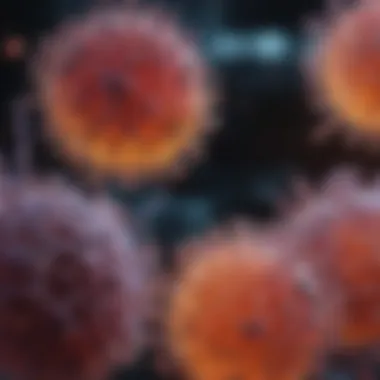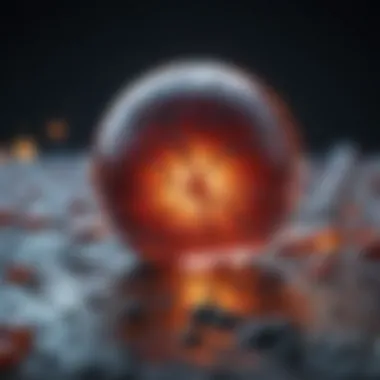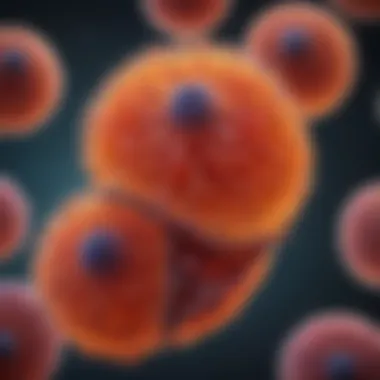Understanding CD34+ Cells: Their Role and Significance


Intro
CD34+ cells play a pivotal role in the realm of hematopoiesis and regenerative medicine. Understanding these cells goes beyond simple definition; it involves delving into their characteristics, functions, and the therapeutic applications that underscore their importance. This exploration aims to provide a comprehensive understandign of CD34+ cells within the current scientific context.
Overview of Research Topic
Brief Background and Context
CD34+ cells originated as a marker for hematopoietic stem cells. They are found mainly in the bone marrow, but also in peripheral blood and umbilical cord blood. These cells have the unique ability to differentiate into multiple cell types, contributing to the formation of blood cells and other tissues. Research into CD34+ cells began in earnest in the late 20th century, and since then, the advancements in stem cell biology and regenerative therapy have increased interest in them.
Importance in Current Scientific Landscape
The relevance of CD34+ cells has garnered remarkable attention in current biomedical research. They are critical for transplantation procedures and have potential implications in treating various diseases. The ability to expand and manipulate CD34+ cells holds promise for tailored therapeutic strategies. This importance is not only recognized in academic circles but also in clinical settings where these cells can impact patient care.
"CD34+ cells are foundational to innovative medicine; their study bridges basic science and real-world therapeutic applications."
Methodology
Research Design and Approach
Research involving CD34+ cells generally employs a combination of laboratory experiments and clinical trials. Various methodologies help explore their properties and applications. The approach often includes isolating these cells from different sources, studying their behavior in culture, and assessing their functionality in therapeutic contexts.
Data Collection Techniques
Data collection focuses on both qualitative and quantitative measures. Common techniques include:
- Flow cytometry to determine CD34 expression levels.
- Colony-forming unit assays to evaluate differentiation capabilities.
- Various imaging techniques to observe cell behavior.
Understanding this methodology allows researchers to grasp how CD34+ cells can be effectively utilized in regenerative medicine.
Prologue to CD34+ Cells
The significance of CD34+ cells cannot be understated in contemporary biomedical research and therapeutic applications. These cells play a pivotal role in hematopoiesis, serving as a prominent marker for hematopoietic stem cells. Their ability to differentiate into various blood cell lineages makes them particularly valuable in regenerative medicine as well as in stem cell transplantation.
Definition and Identification
CD34+ cells are defined by the expression of the CD34 surface antigen, a glycoprotein that serves as a marker for hematopoietic stem and progenitor cells. This designation allows researchers and clinicians to identify these cells in the bone marrow and peripheral blood. Typically, they are isolated using flow cytometry, a technique that enables the sorting of cells based on their specific surface markers.
Understanding how to accurately define and identify CD34+ cells is crucial for both laboratory research and clinical practices. In hematopoietic stem cell transplantation, for example, the number and quality of CD34+ cells can directly impact patient outcomes. Accurate identification ensures that the right cell population is utilized for therapeutic purposes.
Historical Context
The identification of CD34+ cells dates back to the 1980s when researchers began recognizing the importance of this surface marker in hematopoiesis. Initial studies aimed at understanding the behavior of these cells laid the groundwork for subsequent advancements in stem cell biology. Over the years, the role of CD34+ cells has evolved, with significant contributions to our understanding of blood cell formation.
With time, the importance of these cells has expanded beyond hematology to areas like immunotherapy and regenerative medicine. As techniques for isolating and culture-expanding CD34+ cells improved, researchers began exploring their potential applications in treating various diseases, including cancers and genetic disorders. The historical development of this understanding has not only enhanced scientific knowledge but has also opened new pathways for clinical interventions.
"CD34+ cells usher in a new era of therapeutic possibilities, converting intricate biological science into tangible patient care solutions."
Biological Significance of CD34+ Cells
Understanding the biological significance of CD34+ cells is essential for grasping their role in human health and disease. These cells are not merely components of blood; they are pivotal players in various physiological and pathological processes. An accurate comprehension of these cells can illuminate their potential applications in medicine and regenerative therapies, thus shaping future therapeutic strategies.
Role in Hematopoiesis


Hematopoiesis is a complex process through which blood cells are formed, and CD34+ cells are foundational to this process. These cells are primarily found in the bone marrow, acting as a reservoir for hematopoietic stem cells. Their significance lies in their ability to differentiate into various types of blood cells, including red blood cells, white blood cells, and platelets.
Notably, CD34+ cells exhibit the unique property of self-renewal. This characteristic ensures a stable supply of hematopoietic cells, preserving the integrity of the blood system throughout an individual's life. Studies have demonstrated that manipulating the fate of these cells could lead to innovative treatments for disorders such as anemia, leukemias, and other hematological conditions.
Stem Cell Characteristics
The stem cell properties of CD34+ cells are of great interest in biomedical research. Characteristically, these cells are multipotent, meaning they have the capacity to develop into multiple cell lineages. This potential is crucial as researchers explore strategies for stem cell therapy.
Moreover, CD34+ cells express surface markers that facilitate their identification and isolation. This feature is vital for applications in transplantation and regenerative medicine. These cells are often utilized in bone marrow transplants to restore hematopoietic function in patients suffering from conditions such as cancer or severe autoimmune diseases.
CD34+ Cell Isolation Techniques
The isolation of CD34+ cells is a fundamental step in both research and clinical applications. Understanding the methods to effectively isolate these cells is essential for implementing therapies in regenerative medicine and hematopoietic stem cell transplantation. CD34+ cells are markers of hematopoietic stem and progenitor cells, highlighting their potential in various treatments. There are different techniques available, each with specific benefits and considerations.
Physical Methods
Physical methods of isolating CD34+ cells primarily rely on distinct physical properties of the cells. One common approach is density gradient centrifugation. This technique utilizes the differences in cellular density to separate CD34+ cells from other cell types present in the sample. In a typical density gradient, a solution with a specific density is layered, and when centrifuged, lighter CD34+ cells ascend to a layer specific to their density.
Another effective physical method is microfiltration. This approach uses membranes with precisely sized pores to isolate cells based on their size. CD34+ cells can be separated from other cell types, taking advantage of their dimensions. This method is advantageous as it does not rely on any chemical or immunological reagents, thereby preserving cell viability and functionality.
However, these methods are not without limitations. They may require optimization, as the efficiency of separation can vary depending on the sample's characteristics. Additionally, purity of isolated CD34+ cells may be lower compared with other methods. Therefore, researchers must consider these factors when choosing an isolation technique.
Immunological Techniques
Immunological techniques use antibodies that specifically recognize and bind to CD34 antigens on the surface of cells. One of the most widely utilized methods is magnetic-activated cell sorting (MACS). In this procedure, cells are labeled with magnetic beads that are coated with antibodies against CD34. After labeling, a magnetic field is applied, allowing the CD34+ cells to be separated from unlabeled cells efficiently. This method has the advantage of high purity and viability, making it suitable for clinical applications.
Another widely used approach is fluorescence-activated cell sorting (FACS). This technique employs antibodies tagged with fluorescent dyes. After staining, cells pass through a laser, enabling the differentiation between CD34+ and other cells based on their fluorescence. FACS allows for precision isolation and detailed analysis of cell populations.
Despite their high efficiency, immunological techniques come with considerations. They may introduce bias if cells undergo stress from the labeling process, which could potentially impact their functionality. Additionally, the costs associated with antibodies and specialized equipment can be significant. Therefore, proper planning and evaluation are required when implementing these techniques in research and clinical settings.
The choice of method for isolating CD34+ cells significantly affects downstream applications. The right selection is crucial for preserving the functionality and viability of cells, ensuring optimal outcomes in research and therapy.
Clinical Applications of CD34+ Cells
CD34+ cells play a vital role in modern medicine. Their applications vary widely, encompassing not only hematopoietic stem cell transplantation but also advancements in regenerative medicine. Understanding these applications is crucial for those in the medical and scientific communities, providing insights into potential therapies and patient outcomes.
Stem Cell Transplantation
Stem cell transplantation remains one of the most significant clinical applications of CD34+ cells. These cells have the ability to replenish the bone marrow and produce all blood cell types. They are extracted from various sources such as peripheral blood, umbilical cord blood, or bone marrow itself.
Benefits of Using CD34+ Cells in Transplantation:
- Reconstitution of hematopoiesis: CD34+ cells are critical in restoring the blood cell count after myeloablative treatments.
- Versatile sources: Cord blood and mobilized peripheral blood are often preferred due to their availability and ethical considerations.
- Decreased incidence of graft-versus-host disease: Compared to other sources, the use of these cells from umbilical cord blood often results in fewer complications.
The CD34+ cell-based transplant process involves first collecting the cells from the donor, then infusing them into the patient. Close monitoring ensures that the cells engraft properly, leading to recovery. However, the success of this procedure heavily relies on matching donor and recipient tissues, which can present logistical challenges.
Regenerative Medicine
Regenerative medicine utilizes CD34+ cells for a variety of therapeutic strategies targeting tissue repair. The potential of these cells in this field is immense and continues to expand with ongoing research.
Key Aspects of CD34+ Cells in Regenerative Medicine:
- Cellular therapy: These cells can differentiate into various cell types, making them valuable for treating diseases like myocardial infarction or stroke.
- Wound healing: CD34+ cells promote angiogenesis, which enhances tissue regeneration and accelerates wound healing.
- Immune modulation: They have shown promise in modulating immune responses, possibly opening pathways for treating autoimmune disorders.
The application of CD34+ cells in regenerative medicine reflects a proactive approach to repairing damaged tissues. Clinical trials are exploring their effectiveness in various conditions, but challenges such as cell sourcing and differentiation remain.


"The integration of CD34+ cells into treatment protocols is transforming therapeutic options for many previously untreatable conditions."
In sum, CD34+ cells stand as a cornerstone in the realm of clinical applications. Their roles in stem cell transplantation and regenerative medicine demonstrate both the potential and the complexities of harnessing these cells for therapeutic purposes. As research progresses, the landscape of treatment will likely continue to evolve, offering even greater opportunities to enhance patient care.
CD34+ Cells in Cancer Therapies
CD34+ cells play an increasingly pivotal role in cancer therapy. Their unique properties and capabilities make them integral to both the research and therapeutic landscapes in oncology. Understanding CD34+ cells within this context involves examining their applications, benefits, and current considerations when tackling cancer.
Role in Oncology Research
CD34+ cells are often subjects of extensive oncology research due to their association with hematopoietic processes. In laboratories, these cells are studied to uncover their potential roles in tumor microenvironments. This understanding can lead to significant advancements in cancer treatment strategies.
Through the examination of CD34+ cells, researchers aim to identify how these cells interact with tumor cells. This interaction can reveal essential insights about tumor progression and resistance to therapies. For instance, identifying specific markers on CD34+ cells might help understand the tumor-initiating capabilities of certain cancers.
Moreover, studies involving CD34+ cells contribute to the broader field of cancer immunotherapy. By analyzing how these cells can be mobilized or influenced, scientists can work towards creating more effective vaccination strategies against cancer. Unraveling these connections is essential to developing targeted interventions that can enhance patient outcomes.
Potential for Targeted Therapies
The therapeutic potential of CD34+ cells extends to targeted cancer therapies. Harnessing their properties could facilitate the design of treatments that focus on specific cancer types or stages. For example, scientists are exploring how CD34+ cells can be engineered to deliver drugs directly to tumor sites. This specificity minimizes damage to healthy tissues and reduces side effects.
In some cases, CD34+ cells might be used to train the immune system to recognize and eliminate cancer cells more effectively. This customization of the immune response could lead to enhanced anti-tumor activity. Additionally, the ability to generate large quantities of these cells in vitro can support the progress of personalized medicine.
Key Insight: Research into CD34+ cells rapidly evolves, highlighting their crucial role in developing innovative cancer therapies.
By exploring these avenues, ongoing and future studies may pave the way for novel treatment options that go beyond traditional chemotherapy and radiation. The possibilities for combining CD34+ cells with emerging therapies open new horizons in oncology.
Current Research Trends
Research on CD34+ cells is a dynamic field, reflecting ongoing advancements in biotechnology and medicine. Understanding these trends is essential for those engaged in hematopoiesis and regenerative therapies. This section examines emerging technologies and ongoing clinical trials that shape the future of CD34+ cell applications.
Emerging Technologies
The field of CD34+ cell research is being propelled forward by innovative technologies. Techniques such as single-cell RNA sequencing are enabling detailed analysis of gene expression profiles in CD34+ cells. This detailed understanding is vital for understanding cell function and diversity. Moreover, advances in CRISPR-Cas9 gene editing allow precise modifications of CD34+ cells. This technology has significant implications for corrections of genetic disorders in hematopoietic cells.
Another prominent development is the use of microfluidics for cell sorting and analysis. These systems enhance the efficiency of isolating and analyzing CD34+ cells. By dramatically increasing throughput, researchers can collect more data, leading to greater insights into cell behavior in various contexts. Biodegradable scaffolds are also being utilized to create supportive environments for CD34+ cells, improving their viability and functionality in transplantation.
Innovation in technologies surrounding CD34+ cells is paving the way for new avenues in research that could result in novel therapies and improved patient outcomes.
Clinical Trials and Outcomes
Clinical trials involving CD34+ cells are expanding rapidly. These trials evaluate the effectiveness of therapies derived from CD34+ cells in treating various conditions, including leukemia and sickle cell anemia. Noteworthy is the success seen in trials using CD34+ cells for metabolic disorders, highlighting their potential beyond traditional applications.
Outcomes from these trials are carefully monitored to assess therapeutic efficacy and safety. Factors assessed include overall survival rates, quality of life improvements, and the incidence of adverse effects. The data gathered from ongoing trials informs future research directions and protocol development, fostering a deeper understanding of CD34+ cells in clinical settings.
Additionally, patient-specific trials are gaining interest, aiming to personalize treatments based on individual genetic and environmental factors. This shift towards personalized medicine reflects a growing recognition of the complexity of CD34+ cell behaviors and their interactions in heterogeneous populations.
The integration of emerging technologies and clinical trials represents a committed effort to harness the potential of CD34+ cells in modern medicine. As research progresses, the insights derived from these endeavors will likely lead to innovative strategies and therapies that can dramatically improve outcomes for patients in need of stem cell-based treatments.
Challenges in CD34+ Cell Research
Research on CD34+ cells presents several challenges, which are critical to understand for advancing the field. These challenges encompass technical limitations and ethical considerations, both of which can significantly affect research outcomes and clinical applications. Addressing these obstacles is pivotal for harnessing the full potential of CD34+ cells in medicine and science.
Technical Limitations
One prominent challenge in CD34+ cell research lies in the technical limitations involved in isolation and characterization. The methods employed for isolating CD34+ cells can be inefficient, resulting in low yield and purity. Current techniques, such as flow cytometry and magnetic-activated cell sorting, can sometimes prove inadequate in providing the necessary cell quantities for extensive research.


Moreover, the heterogeneity of CD34+ cells complicates their study. These cells can express varying surface markers depending on their stage of differentiation, which further complicates identification and analysis. This variability can lead to inconsistent results across different experimental setups.
"The efficiency of isolation methods directly influences the quality of downstream applications, whether in research or clinical practices."
Additionally, limitations in in vitro culture systems hamper the ability to study the functional capabilities of CD34+ cells comprehensively. These culture conditions often fail to replicate the in vivo environment, affecting cell behavior and functionality.
Ethical Considerations
The ethical considerations surrounding CD34+ cell research cannot be overlooked. These cells are often derived from human sources, including umbilical cord blood and bone marrow. As such, ethical concerns related to sourcing and consent are paramount. Researchers must navigate a complex landscape of regulations and guidelines to ensure that ethical standards are upheld in the collection and use of human tissues.
Furthermore, the potential for misuse of CD34+ cells raises ethical dilemmas. The possibility of manipulating these cells for enhanced regenerative capabilities or even for therapeutic cloning presents both scientific potential and moral questions. Addressing these ethical issues is necessary to maintain public trust and ensure responsible research practices.
In summary, challenges in CD34+ cell research, ranging from technical limitations to ethical considerations, significantly impact the advancement of this field. Acknowledging and addressing these challenges will pave the way for future innovations and applications in regenerative medicine and beyond.
Future Directions in CD34+ Cell Studies
The future of CD34+ cell studies is promising and important for advancing medical science. Understanding how these cells function and how they can be utilized in therapies can transform treatment options for a variety of conditions. This section will explore innovative approaches as well as interdisciplinary collaborations that are shaping the next stages of research in this field.
Innovative Approaches
New methods are constantly emerging for the study and application of CD34+ cells. Researchers are exploring several innovative approaches that could enhance our understanding and utilization of these cells. Some notable methods include:
- Single-Cell Sequencing: This technique allows scientists to analyze the genetic profile of individual CD34+ cells, revealing distinct populations and their functional roles. By understanding the heterogeneity within CD34+ cells, researchers can identify subgroups that may have specific therapeutic applications.
- 3D Bioprinting: This technology enables the creation of complex tissue structures using CD34+ cells. It provides a platform for studying cell behavior in a more physiologically relevant environment than traditional two-dimensional cultures. This opens new avenues for regenerative medicine, where engineered tissues can be developed for transplantation.
"Innovative approaches in CD34+ cell studies hold the potential to unveil new therapeutic strategies that can change lives."
- Gene Editing: Tools like CRISPR/Cas9 technology offer powerful means for modifying CD34+ cells. Researchers can investigate the effects of specific genes on cell differentiation and function. This could lead to the development of tailored therapies for various diseases, including cancer.
These innovative approaches highlight the need for better techniques in CD34+ cell research, which can ultimately benefit patients by expanding the scope of available treatments.
Interdisciplinary Collaborations
Collaboration among various scientific fields presents a unique opportunity to advance CD34+ cell research. By integrating knowledge from different disciplines, significant breakthroughs can occur.
- Basic Science and Clinical Research: Bringing together laboratory researchers and clinicians can help bridge the gap between bench and bedside. Insights gained in the lab can directly inform clinical trials and vice versa. This collaboration ensures that research is relevant and applicable to patient care.
- Bioengineering and Regenerative Medicine: The relationship between bioengineering and stem cell biology is crucial. Engineers can design biomaterials to support CD34+ cell growth and differentiation. These materials can be used in the development of advanced therapies, such as creating artificial organs or enhancing tissue repair.
- Data Science and Bioinformatics: As the volume of data in cell research grows, the collaboration with data scientists becomes essential. Machine learning and statistical tools can refine how data from CD34+ cell studies are interpreted, enabling researchers to uncover patterns that are not immediately visible.
By fostering interdisciplinary collaborations, the future of CD34+ cell studies will be more robust and innovative. This holistic approach can facilitate significant discoveries that directly influence therapeutic strategies in medicine.
The End
The conclusion of this article serves as a vital summary and reflection on the broader narrative surrounding CD34+ cells. By synthesizing the information discussed in previous sections, it is clear that CD34+ cells play a fundamental role in various aspects of biomedical research and clinical practice. Understanding these cells provides insights that are essential for advancing therapeutic strategies in areas such as stem cell transplantation and regenerative medicine.
Summary of Insights
In this article, we explored the definition and characteristics of CD34+ cells, highlighting their significance in hematopoiesis and potential therapeutic applications. Key insights include:
- Role in Hematopoiesis: CD34+ cells are pivotal in the formation of blood cells.
- Stem Cell Characteristics: These cells possess unique properties that allow them to differentiate into various lineages.
- Isolation Techniques: Various methods facilitate the study and application of CD34+ cells, including immunological techniques and physical methods.
- Clinical Applications: Their relevance in stem cell transplantation and regenerative medicine shows how crucial they are for patient care.
- Current Research: Emerging technologies are expanding our understanding of CD34+ cells in cancer therapies and regenerative approaches.
The summary emphasizes that CD34+ cells are not merely biological entities but are critical for future advancements in medical science.
Implications for Future Research
The exploration of CD34+ cells opens several avenues for future research. Some implications include:
- Innovative Therapies: Ongoing studies could lead to new treatment protocols in regenerative medicine and oncology, enhancing patient outcomes.
- Technical Approaches: Advancements in isolation and characterization methods may lead to a deeper understanding of CD34+ cells.
- Interdisciplinary Collaboration: Working alongside geneticists, oncologists, and bioengineers can spur innovative approaches.
- Ethical Considerations: As research advances, it is crucial to address ethical implications surrounding the use of stem cell therapy and related practices.
Research on CD34+ cells will continue to shape the landscape of modern medicine. By fostering interdisciplinary approaches and remaining aware of ethical considerations, scientists can harness the full potential of CD34+ cells to improve therapeutic strategies and patient care.
"Understanding the biological functions of CD34+ cells significantly impacts future healthcare innovations."
In summary, the future of CD34+ cell research is promising, with the potential to unlock further applications and integrate into existing therapeutic frameworks.



